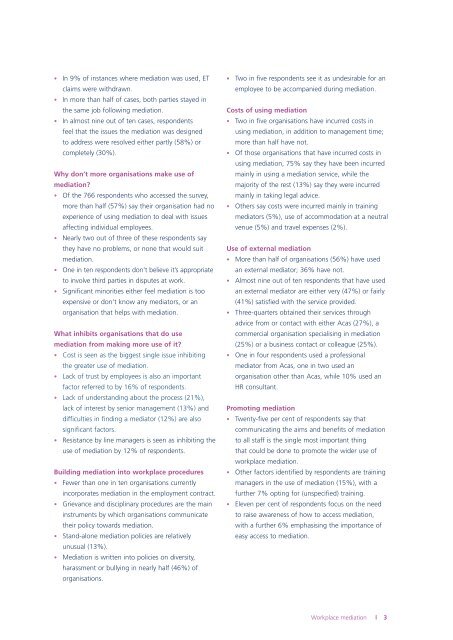Workplace mediation How employers do it - CIPD
Workplace mediation How employers do it - CIPD
Workplace mediation How employers do it - CIPD
You also want an ePaper? Increase the reach of your titles
YUMPU automatically turns print PDFs into web optimized ePapers that Google loves.
• In 9% of instances where <strong>mediation</strong> was used, ETclaims were w<strong>it</strong>hdrawn.• In more than half of cases, both parties stayed inthe same job following <strong>mediation</strong>.• In almost nine out of ten cases, respondentsfeel that the issues the <strong>mediation</strong> was designedto address were resolved e<strong>it</strong>her partly (58%) orcompletely (30%).Why <strong>do</strong>n’t more organisations make use of<strong>mediation</strong>?• Of the 766 respondents who accessed the survey,more than half (57%) say their organisation had noexperience of using <strong>mediation</strong> to deal w<strong>it</strong>h issuesaffecting individual employees.• Nearly two out of three of these respondents saythey have no problems, or none that would su<strong>it</strong><strong>mediation</strong>.• One in ten respondents <strong>do</strong>n’t believe <strong>it</strong>’s appropriateto involve third parties in disputes at work.• Significant minor<strong>it</strong>ies e<strong>it</strong>her feel <strong>mediation</strong> is tooexpensive or <strong>do</strong>n’t know any mediators, or anorganisation that helps w<strong>it</strong>h <strong>mediation</strong>.What inhib<strong>it</strong>s organisations that <strong>do</strong> use<strong>mediation</strong> from making more use of <strong>it</strong>?• Cost is seen as the biggest single issue inhib<strong>it</strong>ingthe greater use of <strong>mediation</strong>.• Lack of trust by employees is also an importantfactor referred to by 16% of respondents.• Lack of understanding about the process (21%),lack of interest by senior management (13%) anddifficulties in finding a mediator (12%) are alsosignificant factors.• Resistance by line managers is seen as inhib<strong>it</strong>ing theuse of <strong>mediation</strong> by 12% of respondents.Building <strong>mediation</strong> into workplace procedures• Fewer than one in ten organisations currentlyincorporates <strong>mediation</strong> in the employment contract.• Grievance and disciplinary procedures are the maininstruments by which organisations communicatetheir policy towards <strong>mediation</strong>.• Stand-alone <strong>mediation</strong> policies are relativelyunusual (13%).• Mediation is wr<strong>it</strong>ten into policies on divers<strong>it</strong>y,harassment or bullying in nearly half (46%) oforganisations.• Two in five respondents see <strong>it</strong> as undesirable for anemployee to be accompanied during <strong>mediation</strong>.Costs of using <strong>mediation</strong>• Two in five organisations have incurred costs inusing <strong>mediation</strong>, in add<strong>it</strong>ion to management time;more than half have not.• Of those organisations that have incurred costs inusing <strong>mediation</strong>, 75% say they have been incurredmainly in using a <strong>mediation</strong> service, while themajor<strong>it</strong>y of the rest (13%) say they were incurredmainly in taking legal advice.• Others say costs were incurred mainly in trainingmediators (5%), use of accommodation at a neutralvenue (5%) and travel expenses (2%).Use of external <strong>mediation</strong>• More than half of organisations (56%) have usedan external mediator; 36% have not.• Almost nine out of ten respondents that have usedan external mediator are e<strong>it</strong>her very (47%) or fairly(41%) satisfied w<strong>it</strong>h the service provided.• Three-quarters obtained their services throughadvice from or contact w<strong>it</strong>h e<strong>it</strong>her Acas (27%), acommercial organisation specialising in <strong>mediation</strong>(25%) or a business contact or colleague (25%).• One in four respondents used a professionalmediator from Acas, one in two used anorganisation other than Acas, while 10% used anHR consultant.Promoting <strong>mediation</strong>• Twenty-five per cent of respondents say thatcommunicating the aims and benef<strong>it</strong>s of <strong>mediation</strong>to all staff is the single most important thingthat could be <strong>do</strong>ne to promote the wider use ofworkplace <strong>mediation</strong>.• Other factors identified by respondents are trainingmanagers in the use of <strong>mediation</strong> (15%), w<strong>it</strong>h afurther 7% opting for (unspecified) training.• Eleven per cent of respondents focus on the needto raise awareness of how to access <strong>mediation</strong>,w<strong>it</strong>h a further 6% emphasising the importance ofeasy access to <strong>mediation</strong>.<strong>Workplace</strong> <strong>mediation</strong> 3

















